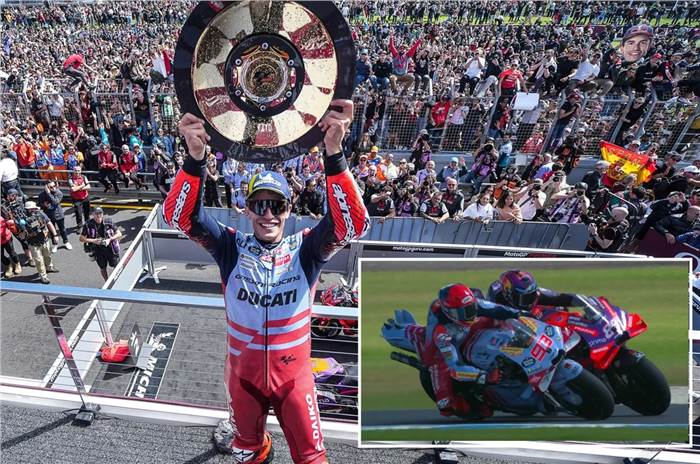MotoGP Sprint Races: A Risk-Reward Assessment

Table of Contents
The Rewards of MotoGP Sprint Races
The addition of sprint races to the MotoGP schedule has undeniably brought several benefits. These shorter races offer a unique blend of excitement and strategic opportunities, impacting both the viewing experience and the championship fight.
Enhanced Spectacle and Fan Engagement
Sprint races are designed to deliver maximum excitement. The shorter format means more intense action from the very start.
- Increased excitement and action-packed racing: The reduced race distance eliminates the prolonged periods of strategic riding often seen in the main races, leading to a non-stop thrill ride for viewers.
- More opportunities for overtaking and thrilling battles: With less time to settle into a rhythm, riders are more inclined to take risks and attempt daring overtaking maneuvers. This results in more close battles and nail-biting finishes.
- Boosts fan interest and viewership, potentially attracting new audiences to MotoGP: The faster pace and increased drama of sprint races can attract casual viewers and broaden the appeal of MotoGP, bringing in new fans to the sport.
- Creates a more dynamic race weekend experience: The addition of a Saturday sprint race transforms the MotoGP weekend from a two-day event into a thrilling three-day spectacle, keeping fans engaged throughout.
Strategic Opportunities and Championship Implications
Beyond the entertainment value, sprint races offer crucial strategic advantages for teams and riders.
- Sprint races offer a chance to gain valuable championship points: Securing a strong finish in the sprint race can provide a significant boost to a rider's championship points tally, potentially altering the championship standings dramatically.
- Provides opportunities for riders to test different race strategies: Sprint races offer a lower-risk environment to experiment with different tire strategies, racing lines, and overtaking techniques. This gathered data can then be used to inform the strategy for the main race.
- Allows teams to gather additional data and fine-tune bike setups: The sprint race provides valuable extra track time for teams to collect data on tire wear, bike performance, and setup, giving them a valuable edge for the main race.
- Can significantly alter championship standings and create more unpredictable outcomes: A strong performance in the sprint race can build momentum and confidence for both rider and team heading into the main race, while a poor performance can negatively impact morale and strategy.
The Risks of MotoGP Sprint Races
While the rewards of sprint races are undeniable, it's crucial to acknowledge the inherent risks. The increased intensity and shorter duration introduce significant challenges.
Increased Risk of Injury and Bike Damage
The compressed nature of sprint races increases the likelihood of incidents.
- Higher probability of crashes due to increased intensity and shorter race distance: The frantic start and close racing inevitably lead to a higher chance of crashes compared to longer races.
- Potential for greater wear and tear on bikes and tires: The intense pace can cause increased wear and tear on both bikes and tires, potentially compromising performance in the main race.
- Increased pressure on riders, leading to higher risk-taking behavior: Riders may be tempted to take greater risks in an attempt to gain a strong position early in the sprint race.
- The added race can contribute to rider fatigue over a race weekend: The extra race adds physical and mental strain on riders, potentially impacting their performance in the main race.
Strategic Complications and Unexpected Outcomes
The sprint race adds a layer of complexity to the already intricate strategic planning of a MotoGP weekend.
- The need to balance sprint race performance with long-term championship goals: Teams must carefully decide how much to prioritize the sprint race versus optimizing performance for the main race on Sunday.
- Risk of sacrificing valuable resources (tires, engine parts) for sprint race performance: Pushing the bike and tires too hard in the sprint race could compromise performance and reliability in the main race.
- The unpredictable nature of short races can lead to unexpected results and negatively affect championship standings: One bad incident or poor strategic call in the sprint race can have a significant negative effect on a rider’s championship aspirations.
- Potential for a negative impact on the main race if resources are over-utilized in the sprint: A compromised bike or worn-out tires from the sprint race can significantly hinder a rider's ability to compete effectively in the main race.
Conclusion
MotoGP sprint races present a compelling mixture of risk and reward. While they undeniably enhance the spectacle of the sport and offer strategic opportunities, they also introduce significant risks, particularly regarding rider safety and long-term championship strategy. Teams and riders must carefully assess the potential benefits and drawbacks before formulating their race weekend plans. The introduction of sprint races to MotoGP is a fascinating evolution. To fully understand their long-term impact, continued analysis and debate on the risks and rewards of MotoGP sprint races are essential. Join the conversation and share your thoughts on the future of this exciting format.

Featured Posts
-
 July Oil Production Opec Gathering For Key Quota Decision
May 29, 2025
July Oil Production Opec Gathering For Key Quota Decision
May 29, 2025 -
 Entertainment Stock Price Dip Analyst Predictions And Recommendations
May 29, 2025
Entertainment Stock Price Dip Analyst Predictions And Recommendations
May 29, 2025 -
 C Est La Vie Lyrics And Eurovision 2025 Netherlands Entry Explained
May 29, 2025
C Est La Vie Lyrics And Eurovision 2025 Netherlands Entry Explained
May 29, 2025 -
 Zoellner Family Honors Outstanding Paraeducator
May 29, 2025
Zoellner Family Honors Outstanding Paraeducator
May 29, 2025 -
 Moto Gp Americas Gp Marquez Takes Pole Extends Perfect Start
May 29, 2025
Moto Gp Americas Gp Marquez Takes Pole Extends Perfect Start
May 29, 2025
